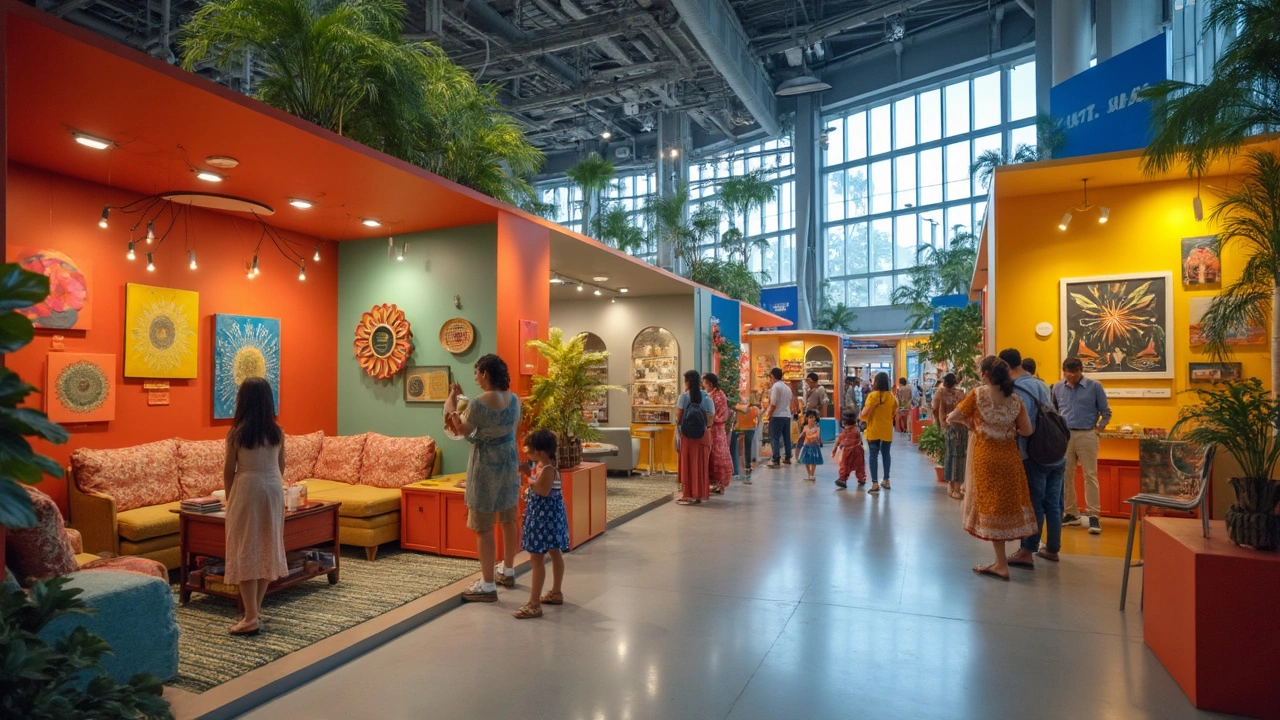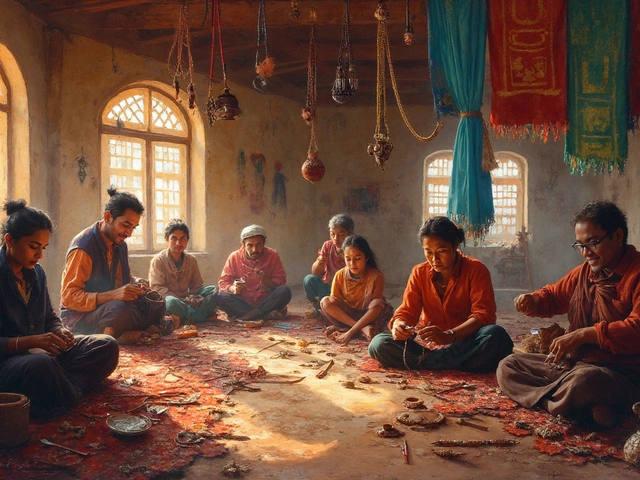Think about this: when IKEA opened its first Indian store in Hyderabad, over 40,000 people walked through the doors on the first day. That’s not just curiosity—it’s a clear sign of serious demand. There’s been a gap in the Indian furniture scene for years: people want affordable, modern designs, but just couldn’t find options that hit both quality and price.
So why would a massive Swedish brand zero in on India? It all comes down to numbers and needs. India has the world’s largest population of young people who are setting up new apartments every day. Urban centers are growing fast. Homeownership is on the rise. People want more than hand-me-downs or overpriced imported pieces—they’re hunting for practical, stylish furniture that doesn’t burn a hole in the pocket.
From the moment you step into a city like Bengaluru or Mumbai, you'll spot a mix of traditional homes and hip, modern apartments. But most furniture manufacturers here are still mostly focused on custom or carpenter-made solutions, often involving long waits and unpredictable prices. So when IKEA announced Indian stores packed with ready-to-assemble beds and that famous Swedish meatball cafeteria, it hit a nerve with a new generation of buyers.
- India: The Perfect Stage for IKEA’s Next Big Move
- The Size of the Prize: Why India’s Market Matters
- Adapting the IKEA Playbook—Swedish Roots, Desi Branches
- Overcoming Indian Challenges: Land, Regulations, and Red Tape
- What India’s Entry Means for Local Furniture Makers
- Tips for Succeeding in India—Lessons from the IKEA Approach
India: The Perfect Stage for IKEA’s Next Big Move
IKEA didn’t just choose India on a hunch. The numbers are loud and clear. India’s urban population has crossed 480 million and is climbing fast. This country adds millions of new consumers to cities every year, all hunting for modern, affordable home products. Most of these buyers are under 35, tech-savvy, and used to global brands, thanks to dozens of shopping apps and a growing middle class.
What makes India even more tempting for a giant like IKEA? It’s a mix of rising local incomes, massive demand for organized retail, and an under-served market for quality furniture. Traditional stores and carpenters still dominate, but they struggle to offer consistent quality or prices at scale. Compare that with the stories from Europe or the US, where big brands have already saturated the market.
Here’s a quick look at the scene IKEA saw when plotting its move:
| Indicator | India (2025) | USA (2025) |
|---|---|---|
| Urban Population | ~480 million | ~285 million |
| Median Age | 28 years | 39 years |
| Annual Furniture Market Size | $36 billion | $120 billion |
| Organized Retail Share | <10% | >90% |
This table spells it out. Compared to places where IKEA already dominates, India has a younger crowd, lots of first-time home buyers, and most furniture still sold in unorganized markets. That’s a goldmine for a brand used to winning over first-timers. Plus, after 2012, foreign retailers in India could own up to 100% of their operations, so the red tape got a little easier to cut through.
If you’re a furniture manufacturer thinking about why big brands like IKEA India made their bet here, look at the potential. With its rapid market growth and a thirst for global-quality home goods, India’s a stage ready for new players who can deliver at scale—and who understand the modern Indian consumer.
The Size of the Prize: Why India’s Market Matters
Here’s the real deal: India’s furniture market isn’t just big, it’s exploding. Back in 2018, the market was valued at around $33 billion. By 2025, people expect it to cross $60 billion. That’s nearly doubling in seven years—faster than the growth in many developed countries. No wonder global brands like IKEA India had their eyes wide open.
What makes India so appealing? Let’s break it down:
- Demographics: Over 50% of India’s 1.4 billion people are under 30. Young adults are moving to cities, setting up homes, and craving affordable style.
- Urbanization: Cities are mushrooming all across the country. Every year, over 10 million people migrate to urban areas—these are new customers itching for beds, sofas, and kitchen setups.
- E-commerce boom: More people are shopping online than ever before. This removes much of the friction for a brand new to the market, and it’s why IKEA rolled out its online store alongside physical outlets.
- Homeownership: Thanks to easier loans and government schemes, more Indians are buying homes, not just renting. New houses mean new furniture, period.
Let’s get specific. Look at how the numbers stack up:
| Year | Indian Furniture Market Size (USD Billion) | Urban Population (Million) |
|---|---|---|
| 2018 | 33 | 460 |
| 2021 | 41 | 500 |
| 2025 (projected) | 61 | 600 |
What’s really wild is that over 90% of the industry in India is still unorganized—those mom-and-pop shops and local carpenters. But habits are shifting fast. More folks want ready-made, branded furniture with warranties and easy returns. For global chains, that’s a wide-open door.
If you’re in the furniture business, this is the place to watch. The customer base is not only giant, but they’re quick to embrace new designs and concepts, especially anything that saves time and fits their budget.
Adapting the IKEA Playbook—Swedish Roots, Desi Branches
IKEA couldn’t just copy-paste its standard formula from Europe or the US and expect it to work in India. The company had to rethink almost every part of its business, right from the color of the sofas to the size of the wardrobes. Homes in India are usually smaller, family structures are different, and even the way people use furniture varies. So, IKEA asked its designers to shrink some furniture, add more storage options, and pick fabrics that handle Indian weather. It’s not uncommon to find bright bedsheets, extra-compact tables, or clever shoe cabinets designed with Indian homes in mind.
One big shift was the menu at the in-store restaurant. While the classic Swedish meatballs are still there, almost 50% of the menu is Indian—think biryani, samosas, and dal makhani. IKEA wanted visitors to feel at home, whether they’re shopping or grabbing a meal. They also kept prices honest. Knowing that the Indian customer is price-sensitive, IKEA introduced over 1,000 products under ₹200 (roughly $2.50), much cheaper than their Western stores.
Sourcing is a huge part of the story. IKEA set an official target to get 50% of its products from India for local stores in the next few years. Today, the company works with over 60 suppliers and employs more than 70,000 people indirectly through its Indian supply chain.
If you’re curious how this looks in numbers, here’s a simple breakdown:
| Category | Global IKEA | IKEA India |
|---|---|---|
| Store Size | 35,000-40,000 sqm avg. | ~37,000 sqm |
| Menu Mix | Mainly Swedish | 50% Indian |
| Products under $5 (₹400) | About 500 | 1,000+ |
| Local Suppliers | About 1,600 globally | 60+ in India |
Here are some things IKEA did differently in India that local IKEA India competitors might want to note:
- Ran over 1,000 home visits in Indian cities to study customer needs first-hand.
- Added more do-it-for-me assembly options since fewer Indians are used to putting furniture together themselves.
- Rolled out special financing and delivery for smaller towns, not just big metros.
IKEA’s adaptation is basically a blend of tried-and-tested Swedish simplicity, but repackaged with plenty of Indian practicality.

Overcoming Indian Challenges: Land, Regulations, and Red Tape
Cracking the Indian market wasn’t a walk in the park for IKEA. Just grabbing land for those gigantic stores turned into a long game. In cities like Mumbai, real estate prices can touch the sky and tracking down a spot big enough for an IKEA warehouse (often over 400,000 square feet) can chew up years. Hyderabad’s first IKEA store took almost five years from land purchase to opening. The reason? Most large plots are tied up in complicated ownership, plus zoning laws are strict.
Navigating local permits and government rules is its own maze. Before 2012, single-brand foreign retailers couldn't even open multi-outlet stores unless they sourced 30% of goods locally. IKEA had to convince policy-makers it would partner with Indian suppliers—now, it’s sourcing home textile, carpets, and even kitchen fronts right here. Getting those approvals involved over 25 rounds of talks with the government.
As for compliance, IKEA has spent millions on sticking to quality and environmental standards. Every new state meant a different tax, paperwork, and sets of regulations. Dealing with GST (the Goods and Services Tax) made things easier but the colonial-era paperwork culture is still a struggle for every new store.
Check out how this played out in numbers:
| Challenge | What IKEA Faced | How Long It Took |
|---|---|---|
| Land Acquisition (Hyderabad) | Finalizing, buying, and clearing land | 2+ years |
| Regulatory Approvals | Business license, environmental, building permits | 3 years |
| Local Sourcing Compliance | Finding Indian suppliers for 30% procurement | 5+ years (ongoing) |
| Staff Recruitment & Training | Hiring locals and onboarding to IKEA’s way | 1 year before each store |
If you’re a local IKEA India competitor, remember: surviving the system requires patience, a local fix-it team, and adapting your playbook for each state. Find a good legal advisor, work with local governments early, and always double-check zoning regulations. Bureaucracy might slow you down, but that first store is worth the hassle if you get it right.
What India’s Entry Means for Local Furniture Makers
IKEA showing up in India was like turning the lights on in a sleepy room. Suddenly, every local manufacturer realized they weren't just competing with the shop next door, but with a global giant known for efficiency and low prices. The impact? A wake-up call and a serious push to step up their game.
First off, IKEA’s arrival has forced many Indian furniture makers to rethink quality and consistency. Before this, most places could get away with wobbly tables or unreliable delivery. Now, people expect products that look good and actually last. Local players are scrambling to match IKEA’s quality control, and some have even joined forces with international brands or invested in better tools and factories.
One very real shift: several Indian suppliers now work with IKEA itself. As of 2024, the company sources from over 60 Indian suppliers producing more than 1,000 different items—from sofas to candles. This partnership means local manufacturers must meet strict standards on sustainability, pricing, and timelines, which nudges the whole sector towards sharper processes.
- IKEA India pushes everyone to innovate, not just copy old designs.
- Delivery and assembly services are now more common across the market, because Indian buyers expect the kind of convenience IKEA delivers.
- Eco-friendly materials and processes are catching on, since IKEA’s model shows that caring about the planet can be profitable too.
But there’s pressure as well. Small workshops and traditional craftsmen, in particular, are feeling the pinch. Some had to cut prices, while others have doubled down on custom or handcrafted pieces that IKEA can’t replicate. So, for local furniture makers, the lesson is simple: adapt, specialize, or risk getting left behind.
Tips for Succeeding in India—Lessons from the IKEA Approach
If you’re a business looking to crack the Indian market, IKEA’s playbook is worth stealing a few pages from. They didn’t just open a store—they dove into how Indians live, shop, and think. That’s why you see crowds even years after their first opening. Here’s what’s worked for them and how you can ride the same wave.
- Localization always wins. IKEA invested close to ₹3,000 crore in its first handful of Indian stores and spent years researching Indian households. Instead of pushing global bestsellers, they designed deeper kitchen drawers for storage-loving Indian families, sold pressure cookers, and offered masala boxes. That’s local thinking in action.
- Pocket-friendly pricing is non-negotiable. IKEA found that roughly 60% of Indian furniture shoppers decide based mostly on price. They rolled out items starting at ₹99, so everyone could walk away with something.
- Supply chains need to get creative. IKEA sources over 1,000 products directly from Indian suppliers. About 27% of all products in Indian stores are made locally, which helps keep costs down and skips import headaches. If you want to scale, building local supply partnerships is a must.
- Build trust with transparency. Indians are wary of complicated assembly and after-sales issues. IKEA started offering assembly services (at an extra charge) and clear return policies—something that still isn’t standard in local furniture retail.
- Reach beyond metros. IKEA’s website saw more Indian shoppers from smaller cities like Jaipur and Kochi compared to big metros. Rolling out online shopping, smaller-format stores, and home delivery gave them reach in every pocket.
| Strategy | Details |
|---|---|
| Product Localisation | Pressure cookers, steel utensils, extra storage beds |
| Pricing | Products starting as low as ₹99 |
| Local Sourcing | 1,000+ products from Indian suppliers, 27% local content |
| Services | Assembly support, easy returns |
| Online & Offline Reach | Presence in 25+ cities through online sales |
Bottom line: the IKEA India experience shows that cookie-cutter strategies from other markets won’t work here. Businesses that want to last in India must show up with flexible pricing, local sourcing, and products that fit how Indians actually live. And don’t ignore the smaller cities—there’s a goldmine of demand waiting outside the usual hotspots.





